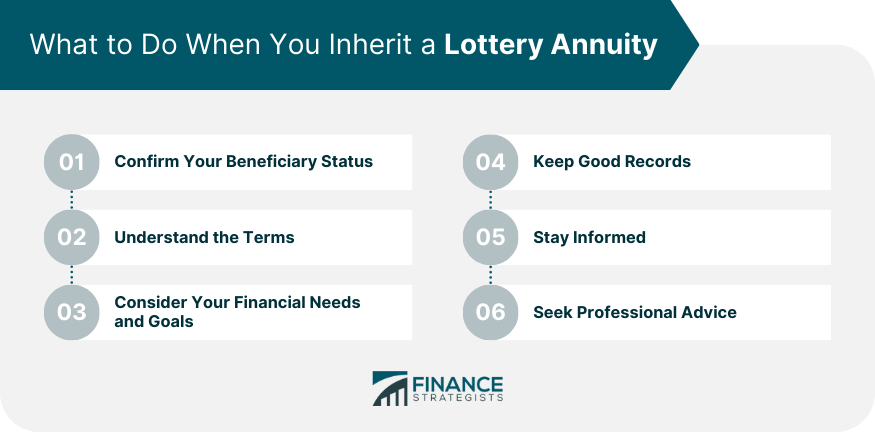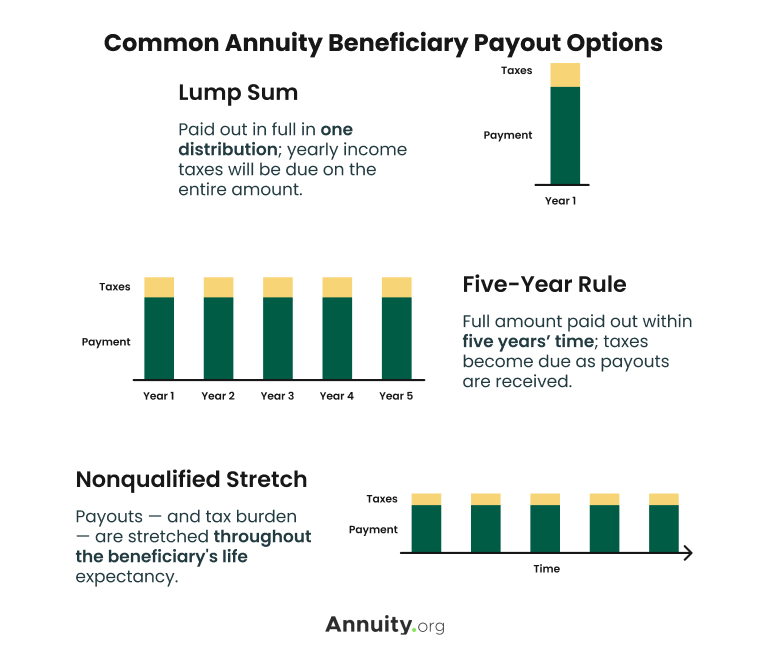All Categories
Featured
Table of Contents

Comprehending the various death advantage options within your inherited annuity is necessary. Very carefully examine the agreement details or speak with a monetary advisor to figure out the certain terms and the very best method to proceed with your inheritance. As soon as you acquire an annuity, you have several choices for receiving the cash.
Sometimes, you may be able to roll the annuity right into a special sort of specific retirement account (INDIVIDUAL RETIREMENT ACCOUNT). You can pick to obtain the entire staying equilibrium of the annuity in a solitary repayment. This option supplies prompt accessibility to the funds yet features major tax consequences.

If the acquired annuity is a qualified annuity (that is, it's held within a tax-advantaged retirement account), you may be able to roll it over into a new retired life account (Deferred annuities). You don't need to pay taxes on the rolled over quantity.
Taxes on Annuity Death Benefits inheritance
While you can't make additional contributions to the account, an acquired Individual retirement account provides an important advantage: Tax-deferred development. When you do take withdrawals, you'll report annuity income in the very same way the plan individual would certainly have reported it, according to the Internal revenue service.
This option provides a steady stream of income, which can be useful for lasting economic preparation. Usually, you should begin taking distributions no more than one year after the owner's fatality.

As a beneficiary, you won't undergo the 10 percent internal revenue service very early withdrawal penalty if you're under age 59. Trying to calculate tax obligations on an acquired annuity can really feel intricate, however the core principle focuses on whether the added funds were previously taxed.: These annuities are funded with after-tax bucks, so the beneficiary usually does not owe taxes on the initial contributions, but any type of profits accumulated within the account that are distributed go through regular income tax.
Taxes on inherited Annuity Death Benefits payouts
There are exemptions for partners that inherit certified annuities. They can normally roll the funds right into their very own individual retirement account and postpone tax obligations on future withdrawals. Either means, at the end of the year the annuity business will file a Type 1099-R that demonstrates how much, if any, of that tax year's distribution is taxed.
These tax obligations target the deceased's overall estate, not simply the annuity. Nevertheless, these taxes normally just influence huge estates, so for the majority of beneficiaries, the emphasis must get on the earnings tax implications of the annuity. Inheriting an annuity can be a complex yet potentially monetarily valuable experience. Understanding the regards to the contract, your payout options and any tax ramifications is vital to making notified choices.
Do beneficiaries pay taxes on inherited Joint And Survivor Annuities
Tax Therapy Upon Death The tax obligation therapy of an annuity's fatality and survivor benefits is can be quite complicated. Upon a contractholder's (or annuitant's) death, the annuity may be subject to both revenue taxes and estate tax obligations. There are various tax obligation treatments relying on who the recipient is, whether the proprietor annuitized the account, the payment approach picked by the recipient, and so on.
Estate Taxes The federal estate tax is a very modern tax obligation (there are several tax obligation braces, each with a higher rate) with prices as high as 55% for very large estates. Upon death, the internal revenue service will certainly include all home over which the decedent had control at the time of fatality.
Any tax in excess of the unified credit rating is due and payable 9 months after the decedent's fatality. The unified debt will completely sanctuary relatively small estates from this tax obligation.
This conversation will certainly focus on the estate tax therapy of annuities. As was the instance throughout the contractholder's life time, the internal revenue service makes a crucial difference between annuities held by a decedent that are in the build-up stage and those that have actually entered the annuity (or payment) phase. If the annuity remains in the buildup phase, i.e., the decedent has not yet annuitized the agreement; the complete survivor benefit guaranteed by the agreement (consisting of any boosted death benefits) will certainly be included in the taxed estate.
What taxes are due on inherited Annuity Interest Rates
Example 1: Dorothy owned a repaired annuity contract released by ABC Annuity Firm at the time of her fatality. When she annuitized the contract twelve years ago, she selected a life annuity with 15-year duration specific.

That value will certainly be consisted of in Dorothy's estate for tax obligation objectives. Upon her fatality, the payments quit-- there is absolutely nothing to be paid to Ron, so there is nothing to consist of in her estate.
2 years ago he annuitized the account picking a life time with cash reimbursement payout choice, naming his daughter Cindy as recipient. At the time of his death, there was $40,000 principal continuing to be in the contract. XYZ will certainly pay Cindy the $40,000 and Ed's executor will certainly consist of that amount on Ed's estate tax return.
Since Geraldine and Miles were married, the benefits payable to Geraldine represent building passing to a making it through spouse. Deferred annuities. The estate will certainly have the ability to make use of the unlimited marriage reduction to avoid taxation of these annuity advantages (the worth of the advantages will certainly be provided on the estate tax obligation form, together with a balancing out marriage deduction)
Taxes on inherited Structured Annuities payouts
In this instance, Miles' estate would consist of the value of the continuing to be annuity payments, however there would certainly be no marital deduction to counter that inclusion. The exact same would apply if this were Gerald and Miles, a same-sex couple. Please keep in mind that the annuity's remaining value is figured out at the time of fatality.

Annuity contracts can be either "annuitant-driven" or "owner-driven". These terms refer to whose fatality will activate payment of fatality benefits.
However there are circumstances in which one person has the contract, and the gauging life (the annuitant) is somebody else. It would certainly be wonderful to think that a specific contract is either owner-driven or annuitant-driven, but it is not that simple. All annuity contracts provided since January 18, 1985 are owner-driven because no annuity agreements provided ever since will be provided tax-deferred status unless it has language that triggers a payment upon the contractholder's death.
Table of Contents
Latest Posts
Understanding Annuities Fixed Vs Variable A Comprehensive Guide to Deferred Annuity Vs Variable Annuity Breaking Down the Basics of Variable Annuities Vs Fixed Annuities Pros and Cons of Tax Benefits
Highlighting the Key Features of Long-Term Investments Everything You Need to Know About Financial Strategies Defining the Right Financial Strategy Pros and Cons of Annuities Variable Vs Fixed Why Cho
Highlighting Fixed Annuity Vs Equity-linked Variable Annuity A Comprehensive Guide to Fixed Vs Variable Annuity Pros Cons What Is Fixed Vs Variable Annuity? Advantages and Disadvantages of Fixed Annui
More
Latest Posts